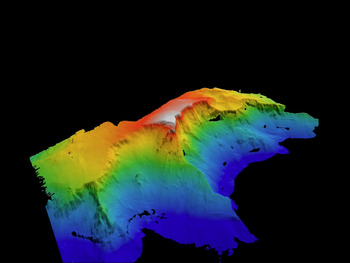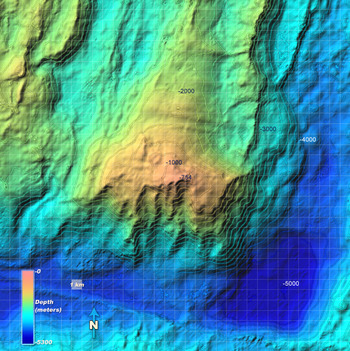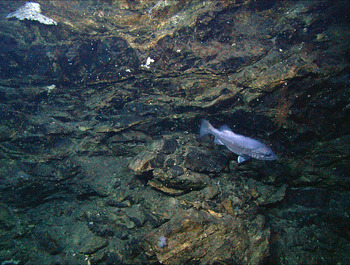The Lost City Hydrothermal Field
http://www.lostcity.washington.edu/Lost City, located 20 km west of the Mid-Atlantic Ridge, is characterized by extreme conditions never before seen in the marine environment: venting of pH 9-11, >90°C, metal-poor fluids from carbonate edifices that tower 60-m above the seafloor. Investigation of this remarkable system has forever changed our views about where and how life can thrive and survive on and in the seafloor and provided new models for the evolution of life on this earth and possibly elsewhere [Kelley et al., 2005]. This system is the longest-lived of any known venting environment in the worlds’ oceans with activity ongoing for at least 120,000 years. Investigations of this site were funded by the National Science Foundation and by the NOAA Ocean Exploration program.
Within the Atlantis Massif, a >14,000 foot tall mountain on which Lost City rests, fluid rock reactions in the ultramafic rocks result in alkaline fluids with high concentrations of abiogenically produced hydrogen, methane, and other low molecular weight hydrocarbons. In concert, these dissolved gases support novel microbial communities. The oxygen-free, interior zones of the chimneys harbor biofilms of a single type of archaea called Lost City Methanoscarcinales that utilizes methane in its metabolism. Bacteria related to CH4- and S-oxidizers, are mostly found in the oxygenated, outer walls of chimneys where fluid chemistry is substantially different than the chimney interiors [Brazelton et al., 2006].
The highly-sculpted, high-surface area of the Lost City structures provides ample space for faunal habitats, and many recovered invertebrates were located within the porous channels and crevices of the carbonate. Surprisingly, while total biomass is low within the field, the field supports a species diversity that appears to be as high as any other known black smoker system on the Mid-Atlantic Ridge spreading center.
The range and complexity of environments hosting peridotites and other ultramafic rocks within the worlds’ oceans is vast and it is unlikely that Lost City is unique. Perhaps the most far-reaching impact of the discovery Lost City-type is the realization that life itself may have originated within these dynamic environments in which geological, chemical, and biological processes are intimately linked.
characterized by extreme conditions never before seen in the marine environment
 Movie showing high resolution bathymetry of Lost City and the life that thrives on the outside of ...
Movie showing high resolution bathymetry of Lost City and the life that thrives on the outside of ... The serpentinite-hosted Lost City Hydrothermal Field is a remarkable submarine ecosystem in which geological, chemical, and biological processes are intimately interlinked
 The Atlantis Massif rises ~14,000 feet above the surrounding seafloor and is formed by long-lived ...
The Atlantis Massif rises ~14,000 feet above the surrounding seafloor and is formed by long-lived ...  Highly deformed serpentinites direclty underlie Lost City. This image was taken with the robotic v ...
Highly deformed serpentinites direclty underlie Lost City. This image was taken with the robotic v ... 
HIghly deformed serpentinite rocks at Lost City
The summit of the massif is capped by flat-lying sedimentary breccias overlain by fossiliferous pelagic limestone. This cap rock was likely important in formation of the field, acting as an impervious lid trapping both fluids and heat. The cap rock is underlain by a 50-100 m thick highly deformed zone that hosts variable altered ultramafic rocks (foliated serpentinite, talc-amphibole schists) and lesser gabbroic rocks. This shear zone is likely the long-lived detachment fault that exposed the mantle and lower crustal rock sequences that make up the massif. This zone grades downward into massive, jointed peridotite with lesser gabbroic rocks that are not highly deformed.
Lost City Hydrothermal Field lies atop the sedimentary cap rock, on a triangular, down-dropped block that forms a terrace on the edge of the south wall. The largest and most active vents are along an east-west trending lineament more than 300 m long. The lineament is intersected by a ~north-south trending fault, which exposes massive, jointed outcrops of serpentinized rocks that form the major north-south ridge that Lost City rests on. The fracture and fault network in the basement provides permeable pathways that control outflow at the main vent sites. In addition to subvertical faults that channel flow to the largest structures, much of the subsurface flow emanates from surfaces that are parallel to basement to gently west-dipping faults. The steep faults expose relatively old, inactive stockworks of carbonate veins and subhorizontal to subvertical open fractures in the basement rock. These are actively leaking hydrothermal fluid and feeding young, white hydrothermal precipitates.